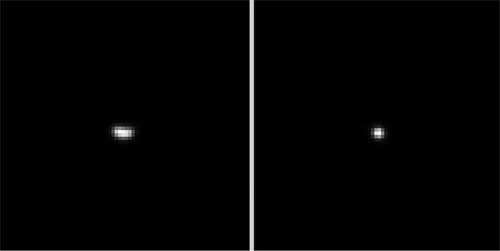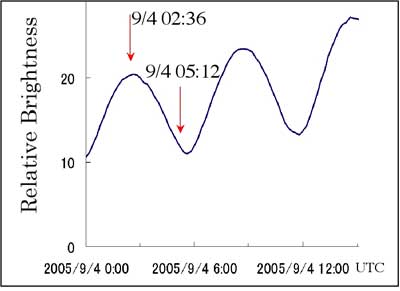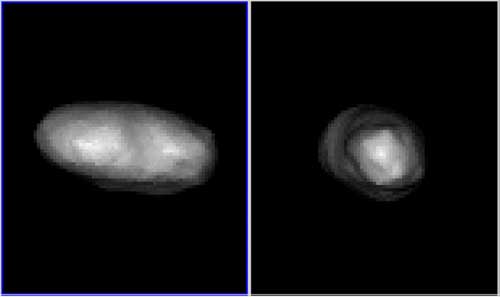TOP > Topics > 2005 > Hayabusa successfully captured Itokawa Shape for the first time in Space
![]()
Hayabusa successfully captured Itokawa Shape for the first time in Space
As of September 4th morning of 2005, Hayabusa is at approximately 1,000 km toward Earth with respect to Itokawa, a near Earth asteroid target of the spacecraft, with the approach speed of 10 km per hour.
Hayabusa took a series of its Optical Navigation Camera aboard on the day and the photos revealed, for the first time in space, the shape information of Itokawa. Left one was taken when the brightness was at the top, while the right one was at the bottom. The upward direction here is almost identical to the north of the ecliptic frame.
Itokawa Images : 9/4 02:36 UTC (left), 9/4 05:12 UTC (right). |
The light curve plot below corresponds to the images above. The images that should be were estimated numerically and those well agree with one another. Note the following model illustrates the shape model obtained based on the ground-based observations including radar measurement performed last year. (Courtesy JPL/NASA)
Relative Brightness of Itokawa |
Itokawa Shape predicted for Sept. 4th Imagery. Ref.Ostro, S. |
The photos actually taken this time supports the model built before launch and also shows the rotation axis is almost perpendicular to the ecliptic plane. This spin axis information also agrees with what was predicted before launch. It is not legible enough but the tip-to-tip length in left photo looks several hundred meters long. The rotation period was estimated about 12 hours before launch, and it well accounts for the observation.
Ostro,S.J., Benner L.A.M., Nolan M.C., Magri C., Giorgini J.D., Scheeres D.
J., Broschart S.B., Kaasalainen M., Vokrouhlicky' D., Chesley S.R., Margot
J.L., Jurgens R.F., Rose R., Yeomans D.K., Suzuki S., and De Jong E.M.
(2004) Radar observations of asteroid 25143 Itokawa (1998 SF36).
Meteoritics & Planetary Science 39:407-424.
September 5, 2005








